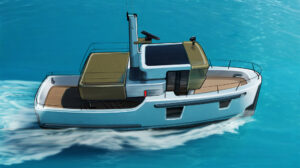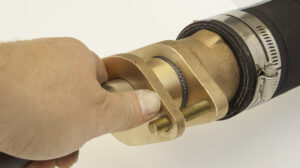
Making the move from polishing your boat by hand to doing it mechanically may be intimidating. You don’t want to mess up that shiny gelcoat, but the thought of spending another day manually massaging compound and polish until your arms almost fall off is pretty persuasive, too.
So let’s say you’ve now decided to upgrade to a power buffer. There are a number of units from manufacturers such as 3M, Makita, and Shurhold, and the most popular models have common features. First up is orbital operation. Traditional polishers spin at a relatively high rate on a single axis. Leave one in one spot for too long and you’ll burn your gelcoat. For my boat, I chose Shurhold’s Dual Action Polisher, which oscillates in a variable orbit across two axes. This means that the buffer is touching the surface it’s polishing in a very random manner thereby avoiding the concentration of power in one spot and the burning and ugly swirl marks that result. Additionally, the 6-inch head is a little smaller than on professional models so it’s easier for a non-pro to handle. And it also saves money in the long run, I think, because it uses less compound and wax than manual methods.
The second key feature to look for in a buffer is variable speed. You need different rpm or speed settings for different types of tasks. For example, the Dual Action Polisher I have has six speed settings, ranging from 2,500 oscillations per minute (OPM) for waxing and buffing, 3,900 OPM for polishing and cleaning, and 6,500 OPM for removing paint defects and oxidation. It also has a 20-foot cord.
Once you have the right equipment, you’ve got to make sure you’re using the correct technique. Spiffing up a boat is not a quick process, even with a power buffer. It might take between six and eight hours to finish even a small job properly.
Start the project by washing down the boat with a dish detergent like Dawn to remove any oil and scum. For tougher stains, use On & Off Hull & Bottom Cleaner. Once the boat is dry, remove any deck hardware that isn’t through-bolted—including cover snaps—and tape off the windshield edges.
Fear of Wet Sanding
So you’ve applied two coats of compound and you’re still not happy with how your boat looks? It may need to be wet sanded. Relax, this is not as scary as it sounds.
Working by hand, use quality sandpaper like 3M’s Imperial 2000-grit product, keep it wet, and work in small areas to remove scratches. If you want to start with a heavier grit, make sure you follow with progressively lighter ones until you get to 2000 and then follow up with compound.
The next step absolutely calls for the right materials. Plain wax does not restore faded gelcoat. It is a UV protectant that will look good for a couple of weeks. Instead, try a compound and polish in one, which removes oxidation, weathering and swirls. Moreover, it’s aggressive enough to remove wet-sanding scratches left by sandpapers as rough as 1500 grit and still produces a high-gloss shine. I personally like Shurhold’s Yacht Brite Pro Polish.
In any case, when you start working, do so in a small area. Applying compound with a rag to the whole boat and then buffing it out is the wrong approach. If it dries on the surface, you’re really not going to improve anything. For compound to work, it needs to be wet.
You can apply polish with a 1-inch paintbrush in three horizontal strips in a 1- by 3-foot area. Then go to a wool pad on a slower speed setting on your buffer. Try to carry the compound down the side of the boat using a side-to-side motion. Once you get to the bottom, make a few passes back and forth with the compound.
A wool pad should be used for more oxidized surfaces, and a foam pad works for less faded surfaces. Avoid banging your buffer against stainless steel hardware, it will likely create a black mark on the buffer pad that will transfer to the gelcoat. For darker hull colors, a second treatment may be needed.
Swirling is a bigger issue than burning your gelcoat. To avoid swirls, clean your buffing pad regularly. You can do this by scraping the surface of the pad with a paint-stirring stick while the buffer is turned on. Even on a relatively small boat, you might need to stop and clean the buffer pad 5-10 times.
By taking your time, and using the right equipment and materials, you’ll take the intimidation factor out of the job while making your boat look great in the end.











